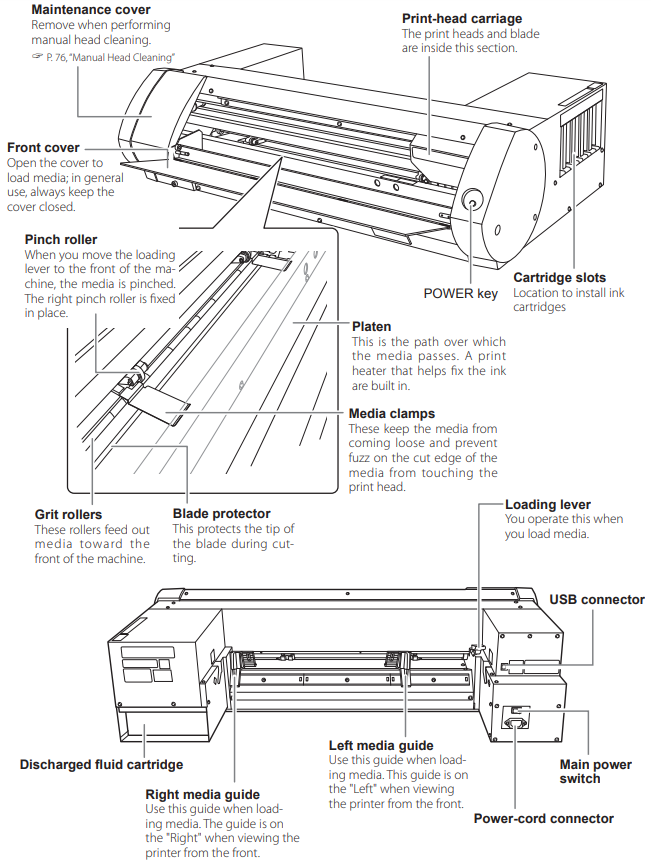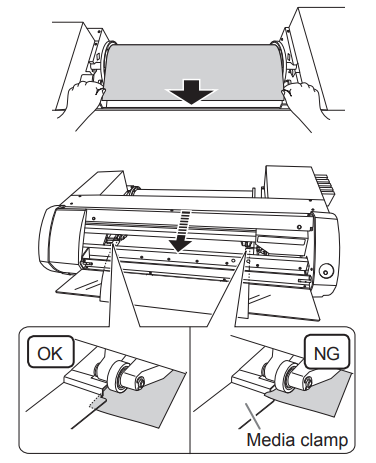Vinyl Printer+Cutter
Make: Roland
Model: BN-20
Ace: Summer Martindale (Makerhub@georgefox.edu).
Location: The Hub
Description
Vinyl Printing is the process of applying ink to vinyl sheets to produce graphics using a conventional inkjet printing method with solvent based inks. This is useful for making images into stickers, creating t-shirt graphics, and any task where the appearance of vinyl needs to be changed. Printers similar to this are standard in small scale custom clothing companies due to how easy it is to take a graphic from Adobe Illustrator to a piece of vinyl. The BN-20 packs everything into one, powerful, profit-producing package. With award-winning eco-solvent inks including metallic and white options, a range of material compatibility and integrated contour cutting, it is easily the most versatile print device in its class. The BN-20 is perfect for creating t-shirt graphics, poster prints, stickers and decals – all from the comfort of your desktop.
Documentation
Terminology
- Graphic - The image, logo, lettering or similar design that is being printed.
- Adobe Illustrator - The software used to set up graphics to be printed.
- Weeding - Removing the excess vinyl material with the tools found in the drawer below the computer.
- Versawoks - The software that interacts with the printer to perform a print.
- Vector images - An image constructed with mathematical formulas which makes it easy to resize and perform other edits.
- Raster images - An image constructed with pixels which means they cannot be resized without a change in resolution.
- See below for specific machine terminology.
User Manual
This user manual does a good job of visually showing the details of operating the printer.
Training
Overview
Almost any file type can be used as a graphic when using the vinyl printer but they all must be brought into Illustrator to add a cut line. Note that a vector file such as a pdf will work the best. The cut line tells the printer to cut out the image that is being printed so it can be weeded properly before it is applied. There are many ways to create a cut line in Illustrator and it is up to the user to determine which process will be the easiest for their graphic. Once a cut line has been created, the file is saved as an .eps and then opened in Versaworks to finalize any print settings before performing the print. After the print is completed it should be left to dry for 20 minutes before being applied to another object.
Demonstration
Print out and weed a graphic of choice. If you are indecisive use a George Fox logo from the website.
General Procedure
Loading Material:
- The vinyl printer is capable of printing on any type or size of vinyl but matte vinyls will provide the best results. Sticker vinyls can be found on the vinyl cutter or in the cabinet under the computer while heat transfer vinyls can be found in the vinyl printer or in the cabinet to the right of the printer. Scrap pieces can be found in the bin next to the computer and are loaded into the printer just like a roll is.
- Press the secondary power button to turn on the printer.
- The loading process always begins by pushing the loading lever backwards. This opens the media clamps so the vinyl can be slid through the printer.
- The media guides are critical to keeping the vinyl in place while printing and must be adjusted to fit the width of the vinyl. Do so by sliding the left media guide to the edge of the vinyl piece. When doing this make sure the pinch roller is above a grit roller or the printer will NOT work. You may have to play with the piece orientation or width to make this possible.
- Feed the vinyl through the printer from the back of machine so that it passes under the media clamps. The purpose of the media clamps is to keep the edges of the vinyl from interfering with the print head so this is an important piece to remember. Feel free to reference the image below.
- Finish the loading process by pulling the loading lever forward and making sure the door is closed. If everything is done correctly the printer will move around the material a bit and then sit quietly. If there is beeping then something is not set up correctly.
Preparing Graphics:
- First, it is important to understand the differences between a vector and a raster when setting up graphics to be printed. Raster images use many colored pixels or individual building blocks to form a complete image. JPEGs, GIFs and PNGs are common raster image types. Almost all of the photos found on the web and in print catalogs are raster images. Because raster images are constructed using a fixed number of colored pixels, they can’t be dramatically resized without compromising their resolution. When stretched to fit a space they weren’t designed to fill, their pixels become visibly grainy and the image distorts. This is why altered photos may appear pixilated or low resolution. Further, because a raster image is composed of many tiny pieces it is difficult distinguish on object from another within the image. Vector images, alternatively, allow for more flexibility. Constructed using mathematical formulas rather than individual colored blocks, vector file types such as EPS, AI and PDF* are excellent for creating graphics that frequently require resizing. Also, each object within a vector file is assigned to a distinct layer within Adobe Illustrator which means an object can be moved, resized, and recolored without affecting the rest of the image. Having a graphic in vector format can be helpful because it is easy to remove the vinyl background from the graphic by adding a cut line around the object.
- Open the graphic in Illustrator 2017 and perform any desired editing. Most of the time nothing will need to be changed with the exception of converting a raster to a vector in order to add a cut line around a specific part of the graphic. To do this:
- Click anywhere on the work page to import the graphic.The graphic can then be converted to vectors by clicking [Object] >[Flatten Transparency].
- Next, click on the image to bring up several options at the top of the screen and select the [Trace] function. When doing this make sure to select the [Expand] option. This will break the image up into components which can be edited individually.
- Note that this process works well for simple images with few colors. If the image is super complicated it will lose a lot of detail and still be difficult to work with because of the many layers that are created.
- In essence, a cut line is a 0.25 pt line (called a stroke in Illustrator) that is correctly colored and labeled so Versaworks can read it properly. The stroke can be added around specific layers (great for logos), or around the entire graphic (better for images). The advantage of adding a stroke around each layer is that it is possible to completely weed out vinyl between two parts of an image instead of leaving a piece of uncolored vinyl. For details on adding the cut line follow the steps below.
- Select the entire graphic and add a 0.25 stroke to the graphic. The [Stroke] option can be found in the toolbar at the top of the screen.
- Click on the color options to the left of the [Stroke] option and then click on [New Swatch] on the bottom edge of the box. A window will open up.
- Name the new swatch [CutContour]. Make sure to use the exact capitalization or it will not work properly/.
- Change the color type from [Process Color] to [Spot Colour]
- Make sure that the color system is set to CMYK
- Drag the magenta bar (M) all the way up to 100 and make sure the other sliders are at 0.
- Hit okay. At this point there should be a bright pink line surrounding the graphic and it is ready to be printed.
- Now that the graphic is ready, save it as an Adobe EPS file (.EPS) so it will be able to be printed in Versaworks.
Printing and Cutting:
- Make sure the material is loaded properly.
- Open up Roland Versaworks. This can be found on the desktop and is where the printing is done from.
- Open the eps file of the desired graphic. There are two different job queues that it can be put into but it doesn't matter which one is used if you are only printing one job. Note: The graphic will appear to be a low quality image in the preview window but this is just how the software operates.
- Double click on the graphic to open a high definition preview of the image to check that everything is working properly. Sometimes the colors may not carry over properly so make sure they look good. If something looks off then there are some color settings that can be changed when saving the EPS file. Mainly, make sure that the cut line is indicated by a moving, dashed, red line surrounding image.
- You might want to change the orientation or other parameters before starting the print; to do this go to [Job] > [Job Settings].
- Finally, right click on the desired file name in the job queue and hit print.
Preparing for Transfers:
Depending on the type of vinyl and the application it is being used for you will have different procedures for transferring the vinyl. When working with the heat transfer vinyl, used for making shirts and such, there are two main ways to do this. First, you can print the mirror of the graphic so that no transfer paper is needed. Second, you can print it normally and then use clear transfer paper to hold everything in place during application. This second option is also used for the standard sticker vinyl and can be done by performing the following steps:
- Use the weeding kit to remove all unwanted sections of the graphic.
- Tweezers are used to pinch and pull up unwanted sections.
- The rounded dental tools are used to hold down wanted sections to prevent them being peeled off with unwanted sections.
- If necessary, cut the graphic off from any excess material.
- Use scissors to cut out a piece of clear transfer paper slightly larger than your cut-out graphic.
- Position it sticky side down over your graphic and use a squeegee to apply it the the graphic.
- This is done starting in the center of the graphic, and smoothed with the squeegee from the center out.
- Once it is applied, flip the layers over and peel the backing of the vinyl material from the transfer paper.
- Peel at the greatest angle possible, aim for parallel to the transfer paper so that none of the vinyl is pulled off.
- The graphic is then ready to be transferred onto the desired material.
Safety
- Never turn off the main power supply. The printer must routinely empty the print head to prevent it from clogging
Certification
Foxtale Quiz
Troubleshooting
Maintenance
General maintenance
Insert text
Specific Maintenance Tasks
| Maintenance Procedure | Frequency | Done By |
|---|---|---|
| Sample | Sample | Sample |


